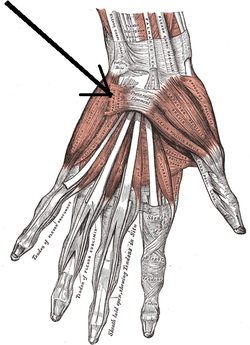Palmaris brevis muscle
 From Wikipedia the free encyclopedia
From Wikipedia the free encyclopedia
| Palmaris brevis muscle | |
|---|---|
 The muscles of the left hand. Palmar surface (palmaris brevis visible at center left). | |
| Details | |
| Origin | Flexor retinaculum (medial) and palmar aponeurosis |
| Insertion | Palm |
| Artery | Palmar metacarpal artery |
| Nerve | Superficial branch of ulnar nerve |
| Actions | Pulls on skin over hypothenar eminence, deepening the cup of the palm and so improving grip |
| Identifiers | |
| Latin | musculus palmaris brevis |
| TA98 | A04.6.02.053 |
| TA2 | 2520 |
| FMA | 37381 |
| Anatomical terms of muscle | |
Palmaris brevis muscle is a thin, quadrilateral muscle, placed beneath the integument of the ulnar side of the hand. It acts to fold the skin of the hypothenar eminence transversally.
Structure[edit]
Origin and insertion[edit]
Palmaris brevis muscle is located on the ulnar side of the hand.[1][2] It arises from the tendinous fasciculi from the transverse carpal ligament and palmar aponeurosis. The muscle fibres are inserted into the skin on the ulnar border of the palm of the hand,[1] and occasionally on the pisiform bone.[3]
Innervation[edit]
Palmaris brevis muscle is the only muscle innervated by the superficial branch of the ulnar nerve (C8, T1).[2]
Blood supply[edit]
Palmaris brevis muscle is supplied by the palmar metacarpal artery of the deep palmar arch.
Discovery[edit]
The first recorded observation of the muscle is by Italian anatomist Giambattista Canano sometime before 1543. The muscle was independently discovered a few years later by Realdo Colombo before being pushed to general acceptance in the works of Andreas Vesalius.[4]
Function[edit]
Palmaris brevis muscle tenses the skin of the palm on the ulnar side during a grip action.[2][3] It also deepens the hollow of the palm.[5] The palmaris brevis may protect the ulnar nerve and ulnar artery from compressive forces during repetitive grasping actions.[6] The muscle has a fatigue-resistant fiber type profile, which supports the idea of a protective function to the ulnar neurovasculature during repetitive intermittent grasping tasks.[7]
See also[edit]
Additional images[edit]
References[edit]
![]() This article incorporates text in the public domain from page 463 of the 20th edition of Gray's Anatomy (1918)
This article incorporates text in the public domain from page 463 of the 20th edition of Gray's Anatomy (1918)
- ^ a b Gray's anatomy : the anatomical basis of clinical practice. Standring, Susan., Gray, Henry, 1825-1861. (40th ed., anniversary ed.). [Edinburgh]: Churchill Livingstone/Elsevier. 2008. ISBN 978-0-443-06684-9. OCLC 213447727.
{{cite book}}: CS1 maint: others (link) - ^ a b c Palazzo, J. J.; Galloway, K. (2017-01-01), Placzek, Jeffrey D.; Boyce, David A. (eds.), "Chapter 53 - Nerve Entrapments of the Wrist and Hand", Orthopaedic Physical Therapy Secrets (Third Edition), Elsevier, pp. 429–436, ISBN 978-0-323-28683-1, retrieved 2021-01-07
- ^ a b "Palmaris brevis". PT Central. 1998. Archived from the original on 4 February 2012. Retrieved 25 February 2012.
- ^ Tubbs, R.S.; Shoja, M.M.; Loukas, M.; Agutter, P. (2019). History of Anatomy: An International Perspective. Wiley. p. 170. ISBN 978-1-118-52425-1. Retrieved 2021-05-05.
- ^ "palmaris brevis muscle (anatomy) - General Practice Notebook". gpnotebook.com. Retrieved 2021-01-07.
- ^ Moore, Colin W.; Rice, Charles L. (December 2017). "Structural and functional anatomy of the palmaris brevis: grasping for answers". Journal of Anatomy. 231 (6): 939–946. doi:10.1111/joa.12675. PMC 5696130. PMID 28786108.
- ^ Moore, Colin W.; Beveridge, Tyler S.; Rice, Charles L. (October 2017). "Fiber type composition of the palmaris brevis muscle: implications for palmar function". Journal of Anatomy. 231 (4): 626–633. doi:10.1111/joa.12652. PMC 5603781. PMID 28620932.
